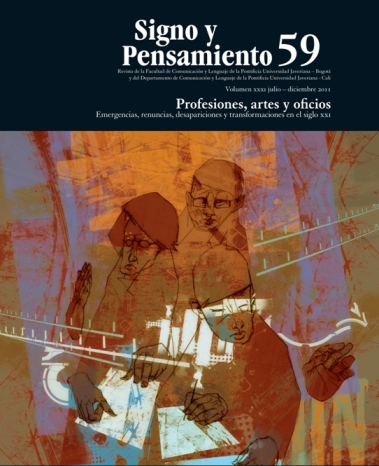Abstract
Thinking communication in the actual contexts involves the assumption of complex scenarios occupied by phenomena and transformations, whose permanent technological and mediatic progress develop communicative/creative processes that allow the arising of innovative communicative structures, which promote debates about an imminently digital culture. The new dynamics whose aesthetic and communicative characteristics take shape from the use of information and communication technology (ICT) trace new ways of understanding, interacting, and training professionals in the field of communication. This article presents the results of a research whose main question was: ¿what is the conception of digital communication and digital aesthetic assumed by teachers who impart lessons related to information and communication technology in the academic programs of Social Communication and Journalism, in the Department of Valle del Cauca (Colombia)?
Deslauriers, J.P. (2005), En la investigación cualitativa, Pereira, Papiro.
Echeverría, J. (1994),Telépolis,Barcelona, Destino.
Giannetti, C. (2002), Estética digital, Barcelona: Asociación de cultura contemporánea. Aesthetics_of_the_digital [en línea], disponible en:http://www.medienkunstnetz.de/themes/ aesthetics_of_the_digital/aesthetic_paradigms/scroll/.
Hernández, I. (2005a). “Imagen numérica y creaciones electrónicas”. En Barbero J.M. - Pereira J.M. & Villadiego, M. (Eds).Tecnocultura y Comunicación.(pp 142-154). Bogotá, Pontificia Universidad Javeriana.
— (2005b, enero-diciembre),“Mundos virtuales, interactividad e imagen numérica”, Kepes, año 2, núm.1, pp. 123-137.
Lévy, P. (1999), ¿Qué es lo virtual?, Barcelona, Paidós.
— (2004),Inteligencia colectiva. Por una antropología del ciberespacio. Figuras de espacio y de tiempo [en línea], disponible en http:// inteligenciacolectiva.bvsalud.org/?lang=es
— (2007),Cibercultura: informe para el Consejo de Europa, Barcelona, Anthropos.
Lizarralde, C. (2008),“La virtualización sensorial” [conferencia], Pereira, Museo de Arte.
Londoño, F. C. (2005, enero-diciembre),“Interfaces de las comunidades virtuales”, Kepes, año 2, núm. 1, pp. 57-92.
Montagu, A.; Pimentel, D., y Groisman, M. (2004), Cultura digital: comunicación ysociedad, Buenos Aires, Paidós.
Moreno, I. (2002), Musas y nuevas tecnologías, el relato hipermedia,Barcelona, Paidós.
Rodríguez, J. A. (2002), “El hipermedia narrativo”,Tecnocultura y comunicación, Bogotá, Pontifica Universidad Javeriana.
Salaverría, R. (2008),“La convergencia tecnológica en los medios de comunicación: retos para el periodismo”,Trípodos, núm. 23.
Silva, M. (2005),Educación interactiva, enseñanza y aprendizaje presencial y online, Barcelona, Gedisa.
Travieso, J. L. y Planella, J. (2008), “La alfabetizacióndigital como factor de inclusión social”,UOC Papers,Universidaa Oberta de Catalunia.
This journal is registered under a Creative Commons Attribution 4.0 International Public License. Thus, this work may be reproduced, distributed, and publicly shared in digital format, as long as the names of the authors and Pontificia Universidad Javeriana are acknowledged. Others are allowed to quote, adapt, transform, auto-archive, republish, and create based on this material, for any purpose (even commercial ones), provided the authorship is duly acknowledged, a link to the original work is provided, and it is specified if changes have been made. Pontificia Universidad Javeriana does not hold the rights of published works and the authors are solely responsible for the contents of their works; they keep the moral, intellectual, privacy, and publicity rights.
Approving the intervention of the work (review, copy-editing, translation, layout) and the following outreach, are granted through an use license and not through an assignment of rights. This means the journal and Pontificia Universidad Javeriana cannot be held responsible for any ethical malpractice by the authors. As a consequence of the protection granted by the use license, the journal is not required to publish recantations or modify information already published, unless the errata stems from the editorial management process. Publishing contents in this journal does not generate royalties for contributors.


